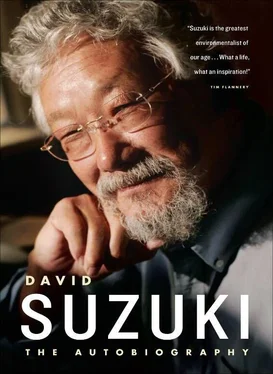THAT NIGHT, AS WE exchanged thoughts through Juneia, Paiakan was sizing me up.
The camera crew were to fly into Aucre in a couple of days, but Paiakan wanted to fly back to Aucre with his wife, Irekran, before the rest of the team. The extra flight would cost several hundred dollars. Nancy Archibald as the producer was worried about the cost overruns we were already racking up and refused to pay. I could see Paiakan and Irekran were anxious to go early, so I offered to pay the money and asked if I could go in with them. Nancy agreed, and the meeting broke up.
The next day, after some of the dancing staged by the women in Gorotire had been filmed, Paiakan, Irekran, and I took off for Aucre. As the plane leveled off, I had a moment of panic as I realized I would be spending the next days in a village where only Paiakan spoke any language other than Kaiapo and that was Portuguese, which I didn't understand. He had learned one English phrase: “Let's go, Dave.” What if something happened and I couldn't communicate with anyone? I would be in the middle of an immense wilderness with no way to communicate with the outside world.
My panic quickly passed, however, as I was swept up in the wonder of the adventure, my childhood dream come true. After an hour's flight over endless, pristine forest, a clearing came into view. I saw an oval ring of huts by a stream, the Rio Zinho, “little river.” A thin cleared track was our runway. We bounced along the stubble to a halt, and the plane was mobbed by what seemed like the entire village.
The women were naked except for beaded necklaces and bracelets, their bodies were painted with black patterns, and their faces were bright red with dyes from plants. Their eyebrows had been plucked, and a triangular area from their foreheads to the crown of their heads was shaved clean. Many of the men, whose bodies were also painted, wore flip-flops, shorts, and headdresses of brilliantly colored feathers. The naked children were painted and bore large holes in their earlobes from wooden plugs. None wore labrets (wooden disks inserted into the lower lip), but many adult men sported holes below their lower lips through which drool dripped. The women wailed in a high-pitched keening, eyes weeping and noses running, to let the arrivals know how much they had been missed. It was astounding to see people like the ones in Dad's magazines. Those had fueled my childhood dreams; these were the real thing.
I was an object of great interest, especially to the children, who had no inhibitions. They jostled about, pushing each other away and bumping into me as they tried to keep a frontline eye on me. Adolescent boys picked up the gear without being told, and we walked in the blazing sun toward Paiakan's hut. The inside of the hut was dark, enclosed by walls of sticks sealed with mud and covered with a thatched roof. A half partition divided the hut, with one side used for hammocks and the other for cooking and eating, and there we hung out.
Paiakan knew I was hot and sweaty. First things first — we walked along a path for a hundred yards until it fell steeply to the river. There women sat on the bank in the shade, putting dough balls onto hooks,

Kaiapo woman in Gorotire prepared to dance
which they threw out into the pool as bait to catch coarse-looking chublike fish called piau. Children dived into the same pool; others dipped metal pots into collecting pools, where clear water seeped out of the riverbank. The girls and women plunged into the pool and, cupping their hands, chanted and slapped the water in a rhythmic song.
It was overwhelmingly idyllic to my North American eye. The water was warm, but it was a wonderful relief from the humid heat. I did wonder about piranhas and learned the next day that people caught them in this same pool. The horrifying tales of piranhas attacking and consuming horses, reducing men to bone in a matter of minutes, turned out to be jazzed-up stories for the adventure magazines I'd loved. I'd also heard about the candiru, the tiny, parasitic catfish that homes in on urea leaking from fish and swims right into the unsuspecting anal pores. I knew the rumor that candiru may follow a trail of urine dribbling from human orifices and swim up urethras. Catfish have sharp spines on their pectoral and dorsal fins, and it is said that the pain of a candiru is beyond belief. Somehow I managed to suppress all such thoughts and just enjoy the scene.
Once my hammock was hung in Paiakan's hut, I wandered around the village circle, looking in doorways and waving at people lying in hammocks or working on chores. On some of the thatched roofs were tethered parrots that I suspect were the source of some of the feathers in headdresses. In the center of the clearing was a covered, wall-less structure where the men gathered to gossip, smoke, weave shoulder bands in which women carried infants, and create the feather ornaments. Their pipes were wicked-looking structures carved out of wood, with a straight stem opening out into a wider bowl where the tobacco was placed. The smoke must have rushed right into the lungs of the smoker. I was glad I had given up smoking a long time ago.
All around the village was forest. In the understory, useful plants such as bananas, pineapples, and cassava could be seen. Agroforestry is the deliberate modification of the forest by people, a practice that has gone on for thousands of years. When Europeans arrived in Africa, Asia, and the Americas, they found what they assumed were pristine wild forests. But it turns out these apparently natural forests had been modified. Villages would be built at the perimeter of wild forests. Over time, plants and trees would be gathered from the wild regions, taken to the villages, and deliberately planted in a perimeter zone to be used as needed. There could be hundreds of species in this zone, and that's why the diversity appeared to Europeans to reflect its wildness. Animals, too, came into the perimeter and were hunted for food. But the villagers knew it was the wild heartland that was the true source of their food.
I returned to Paiakan's hut as the sun approached the horizon. Inside, Irekran was cooking rice and beans in metal pots on the open fire, and in the center of the fire was a dead turtle just plopped on its back onto the coals. Irekran ladled rice and beans onto a tin plate as Paiakan grabbed a leg of the turtle, wrenched it off, and offered it to me. Clearly, it was considered the best part, as everyone watched me, anxiously anticipating an expression of gratitude appropriate to the honor. I smiled and bobbed my head, hoping they could see how happy I was. I had eaten snapping turtle before, when Dad had caught one and we killed and cooked it. As I remembered, the meat was very dark and. . well, it was meat and it hadn't been too bad.
In the middle of the Amazon, I was hungry and any meat seemed fine. The only problem was that this leg was still pretty bloody and hardly cooked at all. Now, I'm Japanese and eat raw fish all the time, yet I couldn't help wondering what kind of parasites might be in a turtle in a tropical rain forest. But what really made it hard for me was the skin, which was covered in bumps and wrinkles that looked so. . alive. And the claws, for some reason, really bothered me.
Nevertheless, I grabbed the leg by the claws and bit into the other end. Mmm, not bad. I really was hungry, and with the rice and beans it was great, but as soon as I finished the leg, a second one was plopped onto my plate — a real honor. I tried to attack this leg with the same gusto, only to have a third leg appear when I finished the second. That was it — I ate three legs and begged off the last one.
Читать дальше



![David Jagusson - Devot & Anal [Hardcore BDSM]](/books/485905/david-jagusson-devot-anal-hardcore-bdsm-thumb.webp)









